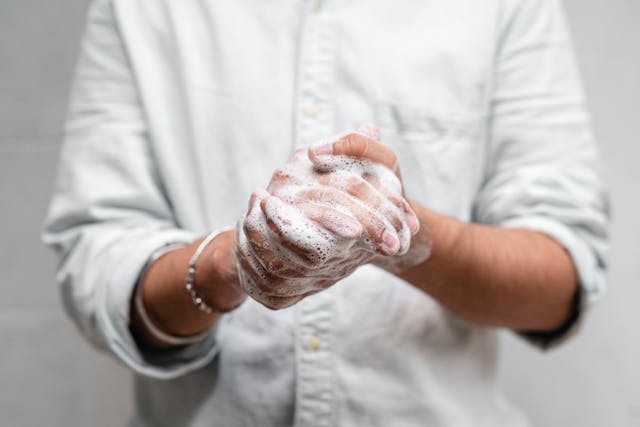
Why does soap produce foam? All foaming soaps contain chemicals that are called foaming agents. As their name implies, their job is to make a foam when you add water and air to the soap.
The main chemicals that you find in soap are ammonium lauryl sulfate and sodium dodecyl sulfate. Both of these are sulfates, which is a salt that is made when sulfuric acid reacts with another chemical. It is a property of these two chemicals that makes them perfect for foaming. All of their molecules are both hydrophobic and hydrophilic. One part of them is hydrophobic, which means it is repelled by water molecules, and the other part is hydrophilic, which means it is attracted to water molecules. Whether a molecule is attracted to another one or not depends on its charge. Water molecules are neutral because they have ten electrons and ten protons, which cancel each other out. However, a water molecule is made up of oxygen and two hydrogen atoms, and the oxygen atom attracts the electrons more strongly than the hydrogen atoms do, making them cluster together at the oxygen end of the molecule. This means that even though a water molecule is neutral, the oxygen end has a slight negative charge. This is the reason why water molecules cling together so well. The slightly positive hydrogen end is always attracted to the slightly negative oxygen end. This property of having slightly different charges is called polarity and polar molecules tend to be attracted to other polar molecules. When another molecule is hydrophobic, it is not polar and it is repelled by the water molecule. When the molecule is hydrophilic, it is polar and it is attracted to the water molecule. Ammonium lauryl sulfate and sodium dodecyl sulfate have one end that is polar and hydrophilic, and one end that is non-polar and hydrophobic.
This hydrophobic-hydrophilic difference is what causes the bubbles. Most of the time, water is attracted to more water. The only places where water isn’t attracted to more water is at the edge. At the surface of the water, the water has nothing to attach to above it, so the molecules try to bind to the water next to them and that gives water a very strong surface tension. When you add soap to the water, one end of the foaming agent attaches itself to the water and the other end is repelled by the water. This happens on two sides of the water. There is foaming agent attached to the outside of the water and there is foaming agent attached to the inside of the water. This is the bubble. There is a thin layer of soap on the outside, then a thin layer of water, and then another thin layer of soap on the inside of the water, like a sandwich where the soap is the bread and the water is the filling. The foaming agent is repelled by the water on all sides and makes the bubble expand, trapping air inside it. It forms a bubble because the foaming agent is not strong enough to break the bonds between the water molecules. When you rub the soap in the water, this process happens quickly and you get a lot of bubbles.
You can make larger bubbles by adding more air into it, but you have to have enough soap and water so that the water molecules can come together and make a strong enough bond. The bubble is mostly air and the water and soap layer are very light, so the bubble will either float up on warm air currents, or very slowly sink down to the floor. When the bubble hits the floor or comes into contact with something sharp, it will burst. This happens again because of the attraction water has for water. Once something sharp breaks the bond in the surface of the bubble, the nearby water molecules will start to stick to each other in clumps, forming droplets. This happens very quickly and it means the bubble no longer has any structural integrity.
The way soap bubbles form is the reason that they can clean us. The hydrophobic end of the foaming agent molecule can stick to grease and oil. When it does, it encloses the grease or oil inside the center of the bubble and carries it away. The foaming agent pushes the water out at the surface of the bubble and keeps the dirt inside. When you rinse the soap off, you are rinsing away all of the dirt and oil that is held inside the bubbles. And this is what I learned today.
Photo by Ketut Subiyanto: https://www.pexels.com/photo/person-washing-hands-4308205/
Sources
https://www.stephensonpersonalcare.com/blog/2018-07-31-what-makes-shower-and-bath-products-foam
https://www.medicinenet.com/what_is_sulfate_used_for/article.htm
https://socratic.org/questions/why-are-some-molecules-hydrophobic
https://www.acs.org/middleschoolchemistry/lessonplans/chapter5/lesson1.html

Pingback: #1124 Why do planes use halon fire extinguishers?
Pingback: #228 What was the South Sea Bubble?
Pingback: #503 Why was the FBI formed?
Pingback: #730 How long do virus and bacteria live for?